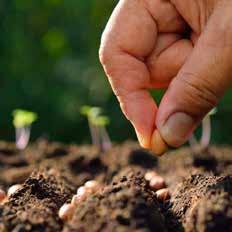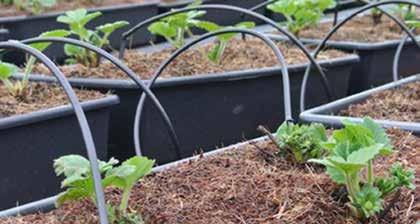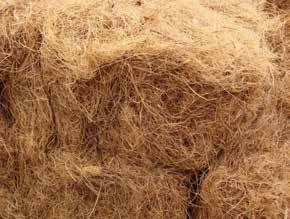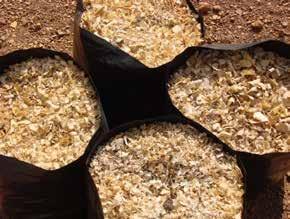
5 minute read
The choice of the correct grow media for your specific crop
The choice of a right grow media is one of the most important choices to make your crop cycle to a success.
Today we have many different options to choose from. We mention amongst others Wood Shavings (Sawdust), Perlite, Bark, Peat moss and last but not least Cocopeat (Coir). Most of the used materials are of natural origin, bearing a risk in it for contamination with soil-born diseases, weeds etc. This goes especially for Bark and for Peat moss and for Cocopeat as well. So it is important to purchase from a reliable, certified Supplier. I have seen too many cases of grow media (Bark) badly contaminated with soil borne diseases.
Advertisement
But for all grow media rules that we need to adjust the Water Management according to the specifications (structure and texture) of the media as well as according to the crop stage.
Requirements
The main property of a grow media is the existence of small pores in it mainly for Water holding capacity and very important the presence of bigger pores for air (Oxygen) holding capacity. As mentioned the majority of our media is from natural origin and we have to anticipate the process of decomposing. As the time goes, the media will change its texture due to the mentioned decomposing with change of water and air holding capacity.
Wood shavings option
Wood shavings are usually easy available, and if you choose for a courser option and put it in closed horizontal so-called ‘pillow’ bags with plant holes on top, this results in a reliable and relatively sustainable medium since the shavings in those closed bags have a better water holding capacity than the ones in the open top bags which are often in the start judged as too dry in the top layer and later in the season all of a sudden very wet in the down part of the bag especially when the finer sawdust is used. The mentioned pillow bags are successfully implemented in cucumbers where even two crop cycles are planted in the same bags before replacing.
Cocopeat option
By far the best option however is Cocopeat since that is the most sustainable choice for most circumstances. It is important to choose for the right mix between course and finer material. In general for Bell peppers we go for the courser mix (60% course/40% fine), tomato 50/50 and English cucumber the finest mix (60% fine). But also we have to take into consideration the Irrigation system. When the water supply is stable and secure, we tend to go for slightly courser material with

lower water holding capacity but with better air holding capacity. Another benefit with courser medium is the easier dry back during overnight and in case of overcast or rainy weather.
14



But also with cocopeat we opt for horizontal closed bags, and not for the open top bags. The latter results also in less efficient use of the top layer. Since this is too dry, so observe hardly any roots in the top. For tomato cropping we advise to replace the bags after one year of usage. Bell Peppers often use the bags one or even two years before replacement. For English cucumbers the practice is to plant two or three crop cycles in the same bag before replacing. The practice of using the slabs for additional planting cycles before replacing makes it viable to invest in this medium with savings on replacement and labour costs.
Other options
Other above-mentioned options I like to point briefly. Perlite is sometimes successfully used or mixed with Peat moss or even in soil as soil improvement. This medium has lots of big bores (air holding capacity) but less water holding capacity. Bark in vegetable crops is trialled but in practice often judged as too wet and not disease free delivered. Bark is worldwide successfully used in pot plant (Orchid) cultures. Last mentioned option Peat Moss is
feeding wat er qual ity 12
pathogens a few years ago, might have deteriorated, needing sterilization before it can be safely used for soil-less crop production. Several laboratories do bacterial counts. As indication of the total number of bacteria in the water (good and bad), they determine the number of ‘coliforms per 100 ml’. Irrigation water should contain less than 1000 coliforms per 100 ml water, but a more reliable norm for the quality of the water is to measure the number of harmful bacteria such as Escherichia coli and Salmonella. widely used as Seedling Mix. And for this option also the choice for a reliable certified supplier is crucial.
Water Management
After choosing the right medium it is important to pay attention to the water management. We have to make the right choices for daily start and stop times of irrigation, shot and interval length as well as drain (run-off) percentage and monitoring. Dryback overnight results in Oxygen penetration to the root zone. Monitoring of the Water Content by weight scales or moisture probes gives you the requested information about your irrigation practices.
Crop Balance and optimal yield
The best performance of a crop and the highest yield can be reached by the right choices in Climate Control, Crop Maintenance and Irrigation / Fertigation practices. This requires an experienced
Grower who is often making use of These bacteria should not be present in the water used for overhead irrigation systems (<1 per 100 ml). With a drip irrigation system, the norm is <10 per 100 ml. Where water is needed to rinse vegetable products, it should be municipality standard and fit for human consumption. According to SANS (2017), this means that the E. coli and Salmonella counts should be <1 per 100 ml water. Apart from chlorination, as used by municipalities and some growers, or hydrogen peroxide, as used by some lettuce and blueberry growers, other sterilization options are also available.


Coaching by a Crop Consultant. Delphy is a Worldwide renowned and independent Research and Consultancy Company. Contact us in case of inquiries and we will try to find the best solutions for making the next step in your Company future.
Due to the importance to have nutrient solutions sterilized before it is reused in closed production systems, several alternative sterilization options will be discussed in the next edition of Undercover Farming. By Dr NJJ (Nic) Combrink of the Horticultural Faculty, University of Stellenbosch. Readers who wish to obtain his very valuable updated manual on Nutrient Solution Management, may contact him at njjc@sun.co.za. Dr NJJ Combrink








